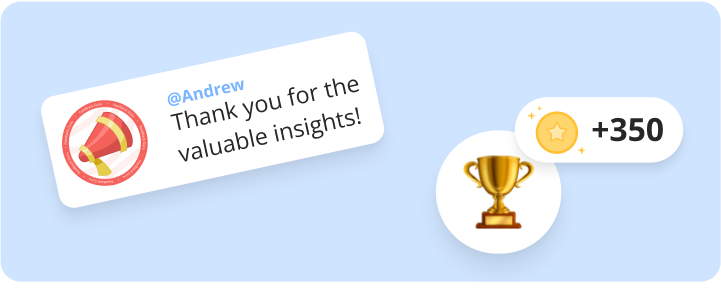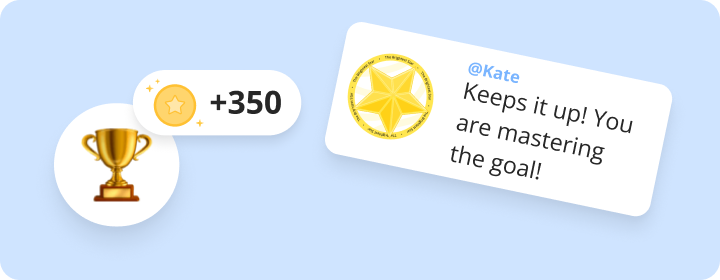20 Key Drivers of Employee Engagement Strategy for 2025
As 2025 approaches, it's the perfect moment to analyze, plan, and refine your employee engagement strategy. This is the season of retrospective workshops, deep dives into past successes and challenges, and exciting plans for the year ahead. With innovations in HR tech set to revolutionize the workplace, 2025 promises to be a game-changer. Yet, amidst this evolution, some elements — like employee wellbeing, recognition, and connection — remain the timeless pillars of engagement.
Whether you're focused on building a more engaged workforce, improving employee retention, or ensuring your culture reflects your organization's mission, understanding the key drivers of employee engagement is essential. And if you're an HR leader or people manager asking, "How can we consistently encourage employees, inspire connection, and create purpose-driven engagement in 2025?" — you’re in the right place.
But before we dive into today’s top drivers, let’s rewind the clock.
How Engagement Drivers Have Evolved Since 2020
The landscape of employee engagement has undergone a seismic shift since 2020. In just five years, the workplace has transformed from office-centric routines to flexible, hybrid ecosystems — and with that change, so too have the key drivers of employee engagement.
In 2020, at the peak of the pandemic, the top employee engagement drivers centered around psychological safety, crisis communication, and feeling secure in an uncertain world. Employees craved empathy from leadership, clarity in messaging, and flexibility in structure. These were not perks — they were survival tools.
By 2021–2022, the focus shifted toward mental health, employee wellbeing, and building resilient teams. Organizations realized that physical and mental health were not separate from productivity — they were prerequisites for it. Employee experience became a top priority, and leaders began implementing more intentional engagement initiatives to support a distributed workforce.
In 2023, we saw personalization take center stage. Recognition moved beyond “Employee of the Month” to tailored moments of appreciation aligned with company values. Employees wanted to be seen as individuals, not roles. The rise of platforms like Esteeme reflected this evolution, making recognition programs more meaningful, scalable, and tied to real-time behavior.
2024 brought further evolution as professional development, internal mobility, and career mapping emerged as mission-critical. With economic fluctuations and talent shortages, employees expected not just support — but growth. Employee motivation became closely linked to whether a company offered visible, accessible paths for professional growth.
Now, in 2025, we see an integration of all these elements: purpose-driven work, employee empowerment, and continuous feedback now exist alongside scalable systems, digital tools, and people-first strategies. Workplace culture has become a competitive advantage, and the most engaged employees are those who feel trusted, heard, and aligned with their organization’s mission.
Understanding how employee engagement drivers have evolved is more than just history — it’s your playbook for the future. By analyzing these shifts through employee feedback, pulse surveys, and employee engagement survey trends, HR leaders can better anticipate what today’s workforce truly needs.
Because what inspired employees yesterday won’t always inspire them tomorrow — but what remains constant is the need to feel human, connected, and valued.
If you want to build a truly future-forward culture, you can't just follow a static blueprint — you need to understand what shapes and reshapes engagement in real time.
What Influences Key Drivers of Employee Engagement?
Employee engagement drivers don’t exist in a vacuum. They’re constantly being shaped by larger forces — from world events to shifting workforce expectations. To build a successful employee engagement strategy, HR leaders must stay attuned to these external influences.

Understanding these trends helps companies respond with agility and purpose — creating strategies that encourage employees, support growth, and reflect what employees feel matters most.
Global Crises: Political instability, financial uncertainty, and global health events can push employees to seek psychological safety and security from their workplace. During these times, transparent communication, empathy, and flexibility become non-negotiable.
Technological Advancements: As AI and automation reshape workflows, engaged employees want tools that support, not replace them. Platforms like Esteeme help maintain a human-centered approach to connection, appreciation, and engagement.
Cultural Shifts: Employees now expect a workplace that champions diversity, equity, inclusion, and corporate social responsibility. These cultural shifts have become critical engagement drivers for younger generations.
Economic Pressures: From inflation to market volatility, financial realities impact employee expectations. Engagement requires addressing job security, fair compensation, and growth opportunities.
Organizational Transitions: Whether through mergers, restructures, or rapid expansion, change can shake confidence. Intentional engagement initiatives become essential to retain trust and motivation.
By considering these external factors, companies can respond to shifting needs — creating strategies that enhance engagement and strengthen workplace culture.
The 20 Key Employee Engagement Drivers for 2025
To build a strategy that truly motivates, retains, and energizes your workforce, you need to understand what fuels engagement — day in and day out. The following key drivers of employee engagement offer a roadmap for HR leaders and business managers alike. Each one is rooted in research, guided by global trends, and supported by real-world success stories. Let’s explore how to activate each of these drivers inside your organization.

1. Flexible Work: The Post-COVID Legacy
Flexible work remains a cornerstone of job satisfaction and employee motivation. Whether it’s fully remote or hybrid, flexibility respects employees' autonomy, enables better work life balance, and fuels employee empowerment. It also strengthens trust and reinforces a more inclusive, positive organizational culture.
Flexibility allows employees to design their schedules around their energy peaks, family needs, or focus windows. When executed well, it boosts engagement, reduces burnout, and supports mental health — all while improving productivity.
For remote workers, flexible schedules allow them to integrate personal needs into their day, which boosts both morale and employee experience. This is one of the most consistently cited engagement drivers in post-pandemic surveys.
Tip: Pair employees across locations for cross-regional team building activities, fostering inclusion even from afar. Leverage platforms that support asynchronous collaboration and performance visibility.
2. Employee Wellbeing: Beyond a Buzzword
Physical and mental health programs are now standard pillars of any meaningful employee experience. Companies must address stress, burnout, and resilience as core parts of their value proposition. Ensuring psychological safety is vital to making employees feel cared for — not just managed.
Wellbeing initiatives span everything from mental health apps and resilience training to quiet workspaces and time-off policies. A culture that prioritizes holistic wellbeing encourages employees to bring their whole selves to work — and stay there longer.
Tip: Implement digital counseling services, host mindfulness sessions, and offer on-demand mental health resources. Track engagement in wellbeing programs using tools like Esteeme.
3. Career Growth & Professional Development Opportunities
Without clear professional development pathways, top talent leaves. Professional growth is a long-term driver of engagement, closely tied to how employees view their employee value proposition.
Employees crave learning — and they want to know their efforts today will translate into new opportunities tomorrow. From upskilling to certifications, growth fuels motivation, retention, and loyalty.
Tip: Launch mentorship programs, internal upskilling academies, or monthly learning labs. Let employees co-create their growth paths, and recognize milestones along their learning journey.
4. Recognition & Appreciation: Fueling Retention
When employees feel valued, they stay. Recognition turns effort into motivation, shaping a positive work environment. It’s one of the most impactful and affordable ways to improve employee engagement.
Recognition builds a culture of gratitude and belonging. It affirms employees’ contributions, amplifies visibility, and reinforces the right behaviors. Both peer-to-peer and top-down appreciation are essential.
Tip: Use Esteeme to connect praise with company values, employee achievements, and everyday behaviors that matter. Make recognition frequent, visible, and inclusive.
5. Clear, Transparent Communication
Employees don’t just want updates — they want context. Transparent communication builds trust, supports alignment, and reduces disengagement. It’s a critical driver in maintaining loyalty during change.
Frequent, open dialogue helps employees understand the "why" behind decisions and feel like trusted participants — not sidelined spectators. Especially during times of change, honesty over perfection wins.
Tip: Highlight success stories company-wide and run regular Ask Me Anything sessions with senior leadership. Use storytelling and inclusive language to help employees understand big-picture strategy.
6. DE&I: Building True Belonging
Diversity, equity, and inclusion aren’t trends. They are vital for attracting talent, improving performance, and building an equitable culture. These values directly influence employee engagement drivers like fairness, community, and psychological safety.
When DE&I is visible in hiring, leadership, and culture, employees are more likely to feel safe and seen. Representation, fairness, and cultural competence fuel connection and long-term engagement.
Tip: Conduct regular pulse surveys and promote ERGs that reflect the demographics of your team. Reward inclusive behaviors visibly.
7. Mission, Purpose, and Company Values
When employees understand and connect with the company's mission, they’re more committed. Purpose fuels performance and boosts employee motivation.
Companies with clear, authentic missions attract passionate employees — and keep them. Linking purpose to daily work builds intrinsic motivation and clarity about where the organization is heading.
Tip: Reinforce values in performance reviews, onboarding, and everyday communications. Esteeme lets you tag recognition with purpose-aligned values, deepening impact.
8. Collaboration Through Technology
In an increasingly digital world, connection can’t be left to chance. Driving employee engagement means equipping teams with tools that streamline collaboration and create visibility for all contributors.
The right tech stack fuels seamless communication, removes barriers, and helps teams stay aligned across time zones. Tools that enable recognition, feedback, and brainstorming in real time are critical for hybrid and global workforces.
Tip: Use shared workspaces, async video check-ins, and recognition tools like Esteeme that integrate into Slack.
9. Autonomy and Empowerment
Empowered employees feel trusted to make decisions. This fuels innovation, accountability, and employee engagement. It also reduces micromanagement and boosts satisfaction.
Autonomy creates a sense of ownership and pride. When employees have room to problem-solve and innovate without constant oversight, engagement thrives.
Tip: Build space for autonomy in your workflows. Trust employees with decision-making authority tied to their roles. Allow room for experimentation and reflection.
10. Social Impact & CSR
Today’s employees — especially Gen Z — want meaningful work. They want to work for organizations that care about the world beyond profit.
CSR-driven organizations attract mission-aligned talent, build positive reputations, and foster loyalty through shared values. Social impact creates deeper emotional connection to the brand.
Tip: Connect employees to purpose through volunteer days, social campaigns, or sustainability projects they can lead. Recognize contributions through Esteeme badges.
11. Continuous Feedback and Growth
Feedback isn’t just for correction — it’s for inspiring employees. Continuous feedback accelerates learning and builds a coaching culture that helps employees feel appreciated and seen.
Effective feedback loops close the distance between effort and acknowledgment. Real-time insights into what’s working (and what isn’t) promote agility and help employees course-correct without fear.
Tip: Use lightweight surveys, weekly check-ins, and manager nudges to build a feedback-rich employee lifecycle. Recognize progress, not just perfection.
12. Community, Culture & Belonging
Belonging is the baseline for engagement. Employees want to feel part of something — a team, a purpose, a shared identity. This emotional glue strengthens retention and trust.
When employees feel they belong, they show up with more creativity, loyalty, and resilience. Connection drives community, and community fuels long-term engagement.
Tip: Celebrate milestones, highlight personal stories, and foster daily connection through informal chats and shout-outs. Make time for meaningful human interaction.
13. Employee Listening & Feedback Loops
True engagement begins with listening. Employees want to know their voices matter — and more importantly, that feedback leads to action. Listening is not just about annual surveys anymore. It's about creating continuous, dynamic feedback loops that inform leadership decisions and shape culture in real time.
When employees feel heard, they feel respected — and are more likely to contribute openly. Regular listening also uncovers blind spots and innovation opportunities.
Tip: Go beyond traditional surveys. Use pulse polls, anonymous suggestion boxes, or platforms like Esteeme that integrate feedback with recognition. Most importantly, close the loop — show how feedback leads to change. When employees feel heard, they feel valued.
14. Onboarding Experience & Early Connection
The first 90 days of an employee’s journey are foundational to engagement. A structured, welcoming, and intentional onboarding process fosters trust, alignment, and purpose — especially for remote or hybrid teams.
First impressions matter. Poor onboarding can increase early attrition, while great onboarding drives retention, engagement, and faster productivity.
Tip: Use onboarding playbooks, assign cultural ambassadors, and schedule welcome touchpoints in the first month. Include recognition and early wins to jumpstart connection.
15. Internal Mobility & Career Mapping
Employees want to see a future inside your organization. Creating clear, visible internal pathways reduces turnover, increases retention, and empowers ownership over one’s career trajectory.
Mobility strengthens loyalty and reduces costly churn. When employees understand how they can grow without leaving, they become more invested in your success.
Tip: Regularly publish internal job openings, build career pathing tools, and celebrate internal transfers or promotions as cultural wins.
16. Manager Enablement & Leadership Development
The employee-manager relationship is one of the strongest predictors of engagement. Equipping leaders with coaching tools, emotional intelligence training, and structured support is key.
Managers shape daily employee experience. If they’re overwhelmed or undertrained, disengagement spreads. But empowered managers fuel clarity, performance, and trust.
Tip: Launch manager bootcamps, feedback training, and role-specific mentorship for new people leaders. Measure manager effectiveness as part of performance reviews.
17. Constructive Feedback & Performance Conversations
Performance management is evolving. In 2025, feedback must be continuous, development-focused, and rooted in mutual respect. Employees expect transparency on how their work connects to impact.
Effective performance conversations align individual goals with company outcomes, helping employees grow and feel seen.
Tip: Ditch annual reviews for frequent check-ins. Create shared goal-setting rituals and peer-led retrospectives to keep feedback two-way.
18. Recognition of Small Wins & Daily Impact
We often wait for big accomplishments — but daily consistency and behind-the-scenes wins matter most. Recognizing everyday effort creates momentum.
Appreciation for small acts keeps motivation high and builds long-term engagement habits.
Tip: Build a shout-out culture using social recognition channels. Use Esteeme to highlight consistent effort, not just milestones.
19. Innovation, Voice & Idea Sharing
Employees are more engaged when their voice shapes how work is done. Empowering ideation improves ownership, psychological safety, and inclusivity.
Ideas come from everywhere — and when leaders encourage bottom-up thinking, they unlock creativity and buy-in.
Tip: Host quarterly innovation jams or suggestion sprints. Let teams vote on and pilot peer-generated ideas.
20. Systems That Reduce Friction
Sometimes, engagement isn’t about adding — it’s about removing blockers. Tools and workflows should enable great work, not complicate it.
Reducing friction reduces frustration. Simplified systems enhance performance and satisfaction.
Tip: Audit your tech stack annually. Let employees flag bottlenecks in systems and propose changes that simplify work.
Turning Insight Into Action: Building the Future of Engagement
The employee engagement drivers we’ve explored aren’t just checkboxes — they’re building blocks of a more inclusive, resilient, and high-performing workplace. From flexible schedules to professional development opportunities, each strategy contributes to an ecosystem where employees feel seen, supported, and inspired.
In 2025, a truly successful employee engagement strategy will be the one that puts people at the center — elevating not only employee experience but also long-term business outcomes. It’s about pairing employees with meaningful opportunities, listening actively, encouraging autonomy, and reinforcing purpose through everyday actions.
The key? Staying agile, people-first, and plugged into your employees’ evolving needs.
How Esteeme Can Help Elevate Engagement
At Esteeme, we believe employee engagement is more than a campaign — it’s a culture. Our platform helps organizations:
Design recognition programs tied to company values and desired behaviors
Drive peer-to-peer recognition through fun, gamified tools
Track progress across the employee lifecycle with built-in analytics
Reward employees with tailored badges, gift cards, and growth-based incentives
Support employee feedback, team building activities, and ongoing campaigns aligned to your company’s mission

Whether you want to increase employee net promoter score, retain top talent, or simply make more employees feel valued and empowered, Esteeme makes it easy to bring your engagement initiatives to life.
👉 Ready to create a culture where employees thrive? Let Esteeme help you drive meaningful, measurable engagement in 2025 and beyond. Book your demo today.
FAQs
- Key drivers include psychological safety, flexible schedules, employee wellbeing, recognition, professional development, and clear communication. These components drive job satisfaction, build a positive work environment, and align people with the organization’s mission.
- Focus on low-cost strategies like peer recognition, employee feedback, shout-outs, and transparent communication. Recognizing employee achievements and building trust through inclusion are powerful, scalable ways to enhance engagement without breaking the bank.
- Employees want to grow. Investing in leadership development programs, mentorship, or access to continuous learning shows that the company values their growth — leading to higher employee motivation and retention.
- Strong employee engagement strategies improve employee retention, productivity, and innovation. Engaged employees drive better company performance through commitment, collaboration, and delivering on the company’s mission.
- Drivers of engagement are the underlying motivators (e.g., work life balance, growth, purpose), while engagement initiatives are the programs or actions companies take (e.g., launching surveys, running wellness campaigns) to activate those drivers and boost the employee experience.







